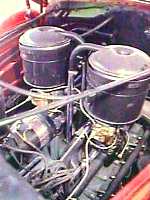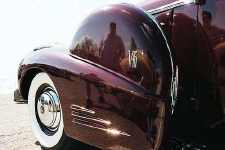|
[ last update: 03.21.2010 ]
The (new) Cadillac Database©
The Cadillac V16
Part 5
The Second Generation Sixteens
1938 - 1940
Return to The (New) Cadillac Database© Index Page
or go back to the "V-16" index page
Unless
otherwise specified all photos and illustrations are from Yann Saunders'
collection of Cadillac photos, advertisements and product catalogs,
reproduced courtesy of the Cadillac Motor Car Division and the Cadillac-LaSalle Club
|
|
The new sixteens were advertised in Country Life and the Sportsman in November 1937. There were no pictures; words were all that was needed to capture the attention of potential buyers, already aware of the high quality of top-end Cadillac models. The new cars made their debut in New York, October 27, 1937.
Cadillac historian, Bill Tite, had an article on the sixteens of 1938 through 1940 in the Self-Starter, magazine of the Cadillac-LaSalle Club, Inc., in February of 1963, on pp. 10-14.
In the three-year period from 1938 to 1940, Cadillac built fewer V-16s than they did the equally rare 1953 Eldorado (498 units of the former as against 532 units of the latter). At least one example of each of these V-16 body style has survived; space permitting, photos of surviving cars will be included here later.
As a matter of interest, the last of the grand V16s left the factory on December 7, 1940, one year exactly before Pearl Harbor ...and ten years exactly before my wife, Gita, was born! This car was delivered to a Wisconsin dealer in Green Bay.
Production records are complete and were thoroughly researched by CLC member Carl Steig in the mid-sixties. The table below has been compiled from his data. The cars are listed in ascending order of rarity (averaged over the three years). The most numerous styles to be sold come first; the rarest ones are last.
A Database user asked me in 2005 for the physical dimensions of the new engine. Should it be of interest to any other users, here they are
Length - 45 7/8"
Height - 18"
Width - 23 3/8"
Crate Volume - 11.1 cu.ft volume
Weight - 1050 lbs incl. clutch and controls plus all accessories[source: Sixteen Cylinder Motorcars by Roy Schneider, p.240 ]
Theme of a 1938 magazine ad
| Job/Style Number |
Description | 1938 | 1939 | 1940 | Total |
| 9033 | Imperial for seven passengers | 95 | 60 | 20 | 175 |
| 9023 | Sedan for seven passengers | 65 | 18 | 9 | 92 |
| 9019 | Sedan for five passengers | 43 | 13 | 4 | 60 |
| 9033F | Formal sedan [imperial] for 7 passengers1 | 17 | 8 | 5 | 30 |
| 9039 | Town sedan for 5 passengers | 20 | 2 | 1 | 23 |
| 9029 | Convertible sedan for five passengers | 13 | 4 | 2 | 19 |
| 9057 | Coupe for two passengers (with opera seats) | 11 | 6 | 2 | 19 |
| 9067 | Convertible coupe for two passengers | 10 | 7 | 2 | 19 |
| 9053 | Town car for seven passengers | 10 | 5 | 2 | 17 |
| 9057B | Coupe for five passengers | 8 | 5 | 1 | 14 |
| 9059 | Formal sedan for five passengers | 8 | 4 | 2 | 14 |
| 9019F | Imperial for five passengers (with division) | 5 | 2 | 0 | 7 |
| 9006 | Two of these special jobs were commissioned by the White House as security cars; it was a convertible sedan for seven passengers | 2 | 0 | 0 | 2 |
| 9053 | Special town car for seven passengers2 | 1 | 0 | 0 | 1 |
| Total V-16 cars (second generation) | 308 | 134 | 50 | 492 | |
| Bare chassis/engine combination3 | 3 | 2 | 1 | 6 | |
| Engines not assigned to any cars [test?] | 4 | 2 | 10 | 16 | |
| Grand Total (135º degree V16 engines) | 315 | 138 | 61 | 514 |
1 Sultry blonde bombshell and actress Mae West was among the first to buy this particular formal body style
2 Although not identified separately in factory literature or production statistics, in my opinion this car is so different as to warrant a separate entry. In fact it is as different as is the Knudsen car, job #9002 (see photo below).
3 At the foot of this page are shown two custom bodies by Derham of Rosemont, that are reported to have been built on the 1940 Cadillac V16 chassis; from the table above, only one 1940 chassis was released to independent coach builders; are we to assume that one of the cars listed was a conversion job on an existing 1940 chassis?
Of the bare chassis/engine combinations mentioned in the previous table, the next table lists those identified as having received special Fleetwood coach work.
Job |
Description |
Quantity |
| 9002 | Four-door fastback sedan built on chassis/engine #5270306 at the end of the 1938 model year for GM Vice-President William "Bunkie" Knudsen. | 1 |
| (?) | A second special job, also on a 148" wheel base chassis, with 1938 V16 chassis/engine # >>>>>>> carried a similar "job" number. It was built for GM Chairman Alfred P. Sloan. Nothing is known of its special features, although I believe the build sheet is available in the factory archives | 1 |
The body shell for the various sixteen-cylinder Cadillac models remained basically unchanged for the three years 1938, 1939 and 1940. Although twelve different Fleetwood styles are listed as having been built on the V16 chassis for 1938 to 1940 [i.e. excluding the two custom-built White House cars and the Knudsen car all built in 1938], there were only seven basic body shells and all of these were shared with cars in the "75" series.
For example, Fleetwood styles #9019, 9019F, 9023 and 9033 all look alike from the outside; all are four-door, six-window styles. Identical also in outward appearance are styles #9033F and 9059; these are the formal styles with leather covered roofs and blank rear quarters. Styles #9057 and 9057B basically are the same too; these are the coupes for 2 and 5 passengers; viewed from the rear, however, style #9057 has a one-piece back light whereas style #9057B has a split rear window.
Interiors of the sixteens for the period 1938-1940 were basically identical in comfort and luxury to the cars in the Series 75. There were only very slight trim variations, including on the door panels.
| Look-alike styles and individual styles
|

The power plant of the
second generation
Sixteens
It is relatively easy to distinguish at a glance between the 1938 models and those for 1939 and 1940; indeed, the fender spears on the 1938 cars have both paint and chrome (the paint being the same color as the body), whereas those for 1939 and 1940 are fully chrome-plated:
|
|
Differences between the 1939 and 1940 models are not so obvious. Ron Van Gelderen, a long-time friend and twice President of the Cadillac-LaSalle Club, Inc., researched in depth the sixteens of 1938 to 1940, long before I became interested in these cars. Most of the drawings below were done by him. He listed the following main differences:
|

Side-mount, tail-light and painted "spears"
on the 1938 Sixteens
One sure way to differentiate between the three model years is to look at the instrument board. These are illustrated below (the same panels were used also in Cadillac V8 and V12 models for those years):
|
|
|
|
Other not-so-obvious differences may be noticed upon a closer observation of the cars of these three model years:
Other differences |
||
|
|
|
|
|
|
|
Shown below are the body styles built on the sixteen-cylinder chassis. The majority of the illustrations are from the luxurious Fleetwood color catalog entitled "The New Cadillac Sixteen", describing the V-16 line-up for 1938. Until production ended in 1940, these cars remained basically unchanged, but for the minor trim variations mentioned above.
The 1938 catalog did not include color plates for all the models, since some of them were identical in outward appearance (see line drawings, above) . For the fun of it, I have added the "missing" plates by modifying or otherwise coloring an existing digital image of a similar model.
Once again, the cars are listed in ascending order of rarity, the most numerous model types coming first:
|
|
|
|
|
|
|
|
|
|
|
|
|
|
|
|
|
|
|
|
|
|
|
|
|
|
|
|
|
|
|
|
|
|
|
|
|
Fleetwood Job #9006
|
|
|
|
|
Job #9002
|
|
Custom body styles built
1938 - Franay
We owe this elegant town landaulet to Paris' coach builder, Franay;
regrettably, information on this superb car is scant; we have only this
poor photo, possibly taken at a Concours d'Elégance in 1939
...just before the outbreak of WW2 in Europe
1938 - [two missing chassis]
Your guess
is as good as mine. These may have been the two special Fleetwood town cars
|
Lee, Don
(USA) is reported to have installed a landaulet body by Willoughby [design #798]
|
1939 - Derham (1)
|
1939 - Derham (2)
|
|
1940 - Derham
|
Trivia: Russell "Rusty" Shepherd, a V16 aficionado wrote this [in 1999]: Again, I really enjoy this site and am especially looking forward to the V16 section. I wish you could see the pictures I was sent of a 1938 V16 7-pass sedan. They had painted it chili-pepper red and the interior was a combination of the original taupe broadcloth and red crushed velour. When the lady who was selling it for the owner called to see what I thought, I told her I had seen that color on a beautifully-restored convertible coupe, so I guess it was available, but I could not imagine anyone ordering a formal car in that color. She said, 'well it was maroon, but he had it repainted in that color.' I then mentioned the two-tone, two-fabric interior. She said it was like that when he bought it and he thought it came that way from the factory. I assured her it did not. She said the engine had been overhauled in 1996, but the air cleaners (about all you can see from the top in that very low, very wide engine) had rust on them. I told her thanks for sending them, and saved $38,000.00! Thanks again for your efforts. Rusty.
Return to The (New) Cadillac Database© Index Page
or go back to the "V-16" index page
© 1996,
Yann Saunders and the Cadillac-LaSalle Club, Inc.
[ Background image: V16 grille, current 1938 through 1940 ]